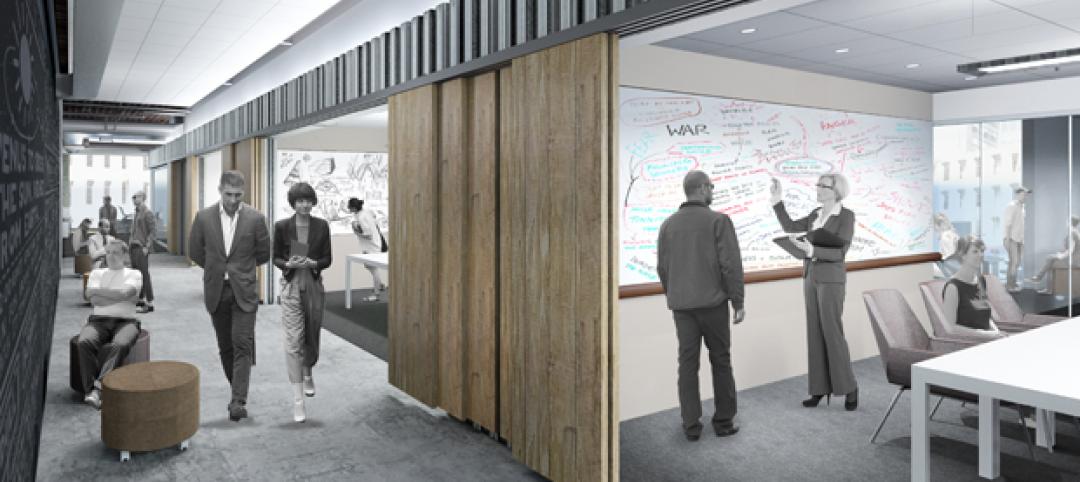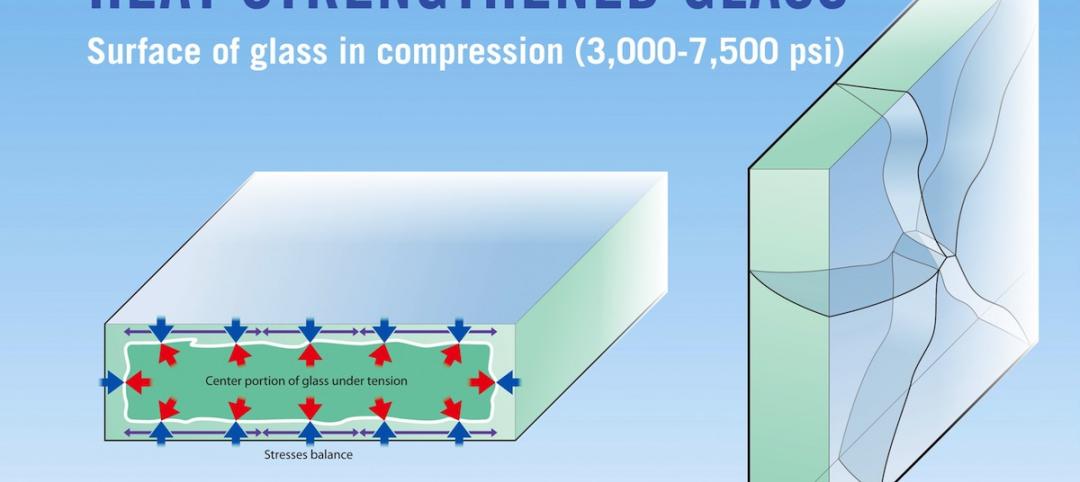Soaring to a height of 1,776 feet (540-meter), the 2.6-million-sf (242,000-square-meter) building soon to become the new One World Trade Center in the lower Manhattan district of New York City is a marvel of design and engineering. Construction of the building, previously dubbed the Freedom Tower, began in April 2006 and, when it is completed in 2013, it will be the tallest building in the U.S.
The building will feature an expansive public lobby, a series of mechanical floors, followed by 69 office floors that will include two television broadcast floors, mechanical floors and two restaurants. There will be an observation deck and parapet above these floors, and at the crown, a communications platform and a 408-foot (125-meter), cable-stayed antenna. Below-ground, concourses will offer 55,000-sf (5,100 square-meters) of retail space.
Sustainable design is central to One World Trade Center's development, integrating renewable energy, interior daylighting, reuse of rainwater and of recycled construction debris and materials. But one of the most sustainable elements of the structure is so integral to the mammoth skyscraper’s strength and durability that it might surprise you.
Concrete
The structural columns of One World Trade Center are comprised of steel and concrete. The compressive strength of concrete for these columns is divided into four phases starting at 14,000 psi (97 MPa) at the bottom of the building, and progressing through 12,000 psi (83 MPa), 10,000 psi (69 MPa) and 8,600 psi (59 MPa) to the top. The 12,000 psi (83 MPa) concrete phase of the project was extremely challenging, with the engineers, owners and contractors all having their own requirements and specifications.
Engineering requirements:
- Compressive strength: 12,000 psi (83 MPa) @ 56 days
- Over-design for safety: 1,900 psi (13 MPa)
- Modulus of elasticity: 7.0 million psi (48 GPa)
- Heat of hydration: Not to exceed 160 OF (70 OC)
- Non-air-entrained
Port Authority of New York/New Jersey:
- Quantity of portland cement in the mixture: Less than 400 lb/yd3 (240 kg/m3)
Contractor requirements:
- Slump flow: 22 – 26 inches (560 - 660 mm)
- Ability to pump to at least 40 floors
- No loss in concrete workability during transit and placement
- Aesthetically pleasing
To achieve the desired concrete properties, concrete producer Eastern Concrete Materials, Elmwood Park, N.J. and admixture supplier BASF Construction Chemicals, Beachwood, Ohio, partnered to develop a special high-strength, sustainable concrete mixture. This mixture was used for the 38,000 yd3 (29,000 m3) of concrete needed for the columns through the first 40 floors.
One of the biggest challenges in developing this concrete mixture was meeting the Port Authority of New York/New Jersey’s strict requirement for the replacement of cement. Through BASF’s Green Sense Concrete mixture optimization service, Eastern Concrete Materials was able to proportion a concrete mixture that met this requirement and allowed for the use of high levels of recycled materials. The mixture substantially replaced portland cement with the recycled materials, as well as silica fume, non-cementitious fillers and Glenium high-range water-reducing admixtures to exceed all the performance targets specified by the One World Trade Center project stakeholders.
To determine the environmental impact, an Eco-Efficiency Analysis of the concrete mixture was conducted, using a methodology validated by NSF International, to compare the specialized Green Sense Concrete mixture to a reference mixture. The results of this cradle-to-gate analyses included fresh water savings of 30,492 gallons (115,400 liters), energy savings of over 8 million kWh, air emissions savings of 12 million lb (5445 tonnes) of CO2, solid emissions savings of over 400,000 lb (180 tonnes) and fossil fuel savings of 750,000 lb (340 tonnes).
“We are extremely proud to be part of this historic and iconic project,” said John Salvatore, Head of BASF Construction Chemicals Americas. “But we are especially proud of the collaboration and innovation that was brought to bear in order to make a significant contribution to the enhanced sustainability of One World Trade Center.”
For more on innovative admixtures, click here to visit BASF Admixture Systems. +
Related Stories
| Mar 1, 2014
Dramatic fractal roof highlights SOM's new Mumbai airport terminal [slideshow]
The terminal merges new technology and traditional regional architecture, notably in the fractal roof canopy that runs throughout the terminal.
| Feb 28, 2014
Six finalists selected in design competition for Canadian Holocaust monument
David Adjaye and Daniel Libeskind are among the finalists for the National Holocaust Monument, planned near the Canadian War Museum in Ottawa.
| Feb 27, 2014
Gensler reveals 44 design trends for the next decade
The 82-page report covers dozens of emerging trends in healthcare, commercial office, hospitality, tall buildings, and more.
| Feb 27, 2014
Target converts former prison dump into latest big-box store
Target's new San Rafael, Calif., location was built on the site of the former San Quentin prison dump.
| Feb 27, 2014
Open or private offices? It depends on the business plan
Open layouts are grabbing headlines as a hallmark of the new workplace—think the Google campus or Facebook's headquarters. And for smaller-scale operations, open designs are often lauded for being less expensive than private office plans. But does that mean all offices should have an open layout?
| Feb 27, 2014
3 reasons to apply computational fluid dynamics on your next project
From right-sizing mechanical systems to understanding the impact of design alternatives, CFD offers a host of benefits for the Building Team.
| Feb 27, 2014
12 facts about heat-treated glass: Why stronger isn’t always better
Glass is heat-treated for two reasons: the first is to increase its strength to resist external stresses such as wind and snow loads, or thermal loads caused by the sun’s energy. The second is to temper glass so that it meets safety glazing requirements defined by applicable codes or federal standards.
| Feb 27, 2014
Metal Construction Association introduces two Environmental Product Declarations
Two Environmental Product Declarations (EPD), one for Metal Composite Material Panels and one for Roll Formed Steel Panels for Roofs and Walls, are now available free of charge from the Metal Construction Association (MCA) on its website.
| Feb 27, 2014
Bluebeam Software launches Revu 12 for better field-ready document management and project collaboration
The latest version of the company’s flagship solution better enables users in document-intensive industries to digitally collaborate on project documents and more easily connect the office to the field.
| Feb 27, 2014
PocketCake lunches CPU designed for virtual reality simulations
The company's Virtual Reality Simulation Converter Assembly is three times more powerful than the average high-performance computer and allows for up to eight people to experience a virtual reality simulation at the same time.
















